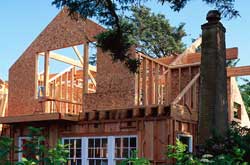Choosing Green with Brick or Stone Siding
See if We Have Top-Rated
Green Professionals in Your Area

Green homes strive to be healthy, energy efficient, durable, long lasting, and environmentally responsible, and the siding you put on your home plays a large role in achieving those ends. If you're thinking about greening your new siding installation, here's a guide, drawn from the wisdom and knowledge of green remodeling expert David Johnston, to help ensure your siding installation is as green as they come (or at least as green as you want it to be).
Brick or Stone Siding: Green Siding that Lasts
Brick and stone siding rank right up there with some of the greener siding solutions a homeowner can opt for. Why? Going green isn't just about improving energy efficiency, though brick and stone siding will deliver in that department. It's also about using high-quality, long lasting, and healthy home siding alternatives. Compared to composite siding materials like vinyl that can fail in just about every category mentioned above, or a natural material like wood siding that contributes to environmentally destructive practices like deforestation, brick and stone siding certainly qualify as a bonafide green siding solution for homeowners looking for a more environmentally friendly way to protect their home.
It's Easy Being Green
David Johnston isn't just any green remodeling expert. He's the founder of the green consulting firm What's Working, Inc., the author of the Nautilus Award winning book Green Remodeling: Changing the World One Room at a Time, and HomeAdvisor's most trusted adviser on green remodeling. Johnston is a realist when it comes to setting budgets and keeping costs reasonable, but he also warns homeowners against getting caught up in what he calls "the payback trap" of green remodeling. In his view, the true value of green remodeling extends far beyond initial costs or estimated energy savings.
Case in point: opting for a brick or stone siding installation will probably cost you substantially more than some other siding alternatives on the market. On the other hand, brick and stone siding offers homeowners the advantages of some of the highest quality siding materials on the market, lifespan that are measured in decades, if not centuries, and a healthier home for you and yours. Add to that the value of knowing that you'll be passing a better world on to your children and grandchildren, and it's easy to see what Johnston means when he says the true value of going green extends far above the bottom line.
Green Siding: Dollars and Sense
When it comes to going green with your siding materials, there are two things that homeowners should keep in mind. The first is that green remodeling places a premium on building philosophies that make sense, especially when it comes to matters like health, quality, and energy conservation. The second thing is that those same philosophies result in homes that are longer lasting, require less maintenance, and reduce energy consumption. In other words, they're homes that save you money in the long run.
Other Types of Green Siding
Brick and stone are superb insulators for residential cladding, but they're far from the only green siding options. Indeed, your entire siding system and design is more important than the exterior cladding material itself. Everything from joist spacing to interior paint will have an impact on the overall, energy-efficiency of your home's walls. Here are how different siding materials use their inherent qualities to create the best siding possible for your home and the environment:
- Vinyl Siding: Vinyl siding has a low thermal mass, but siding manufacturers know this and often include premium insulating and installation guidelines to help deliver green siding for your home.
- Fiber-Cement Siding: Heavier than vinyl, fiber-cement siding also gets a boost from its tightly fit and durable installation process. Fiber-cement is a growing favorite amongst green- and budget-minded homeowners.
- Wood Siding: There are few issues with energy-efficiency and wood siding, but the use of raw materials and the need for on-going chemical treatments and staining makes this a dubious choice for green-minded homeowners.
- Stucco Siding: If you're not crazy about brick or stone, this is the next best alternative with some of the highest overall insulating values out there. Unfortunately, other than brick or stone, stucco is also likely to be the most expensive option.
If you think green siding is the right choice for you, talk to your contractor about adopting a green building philosophy, find a contractor who specializes in green building and remodeling, or seek out the services of a green consulting firm to help you plan and design the best, and greenest, siding project you possibly can.
More Tips & Advice For Your Home
- Related Articles
- Recent Articles

